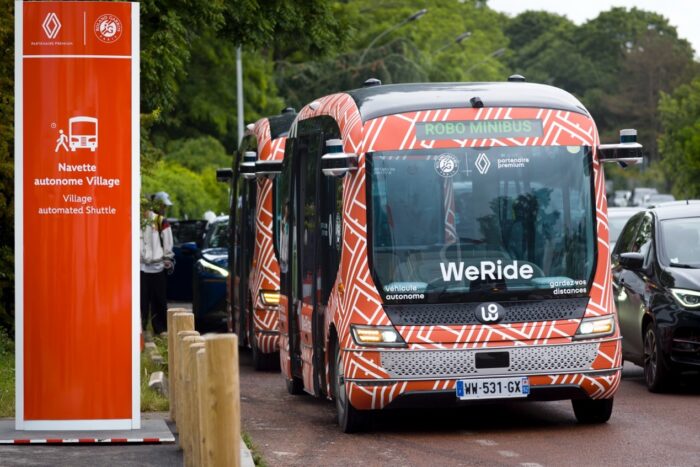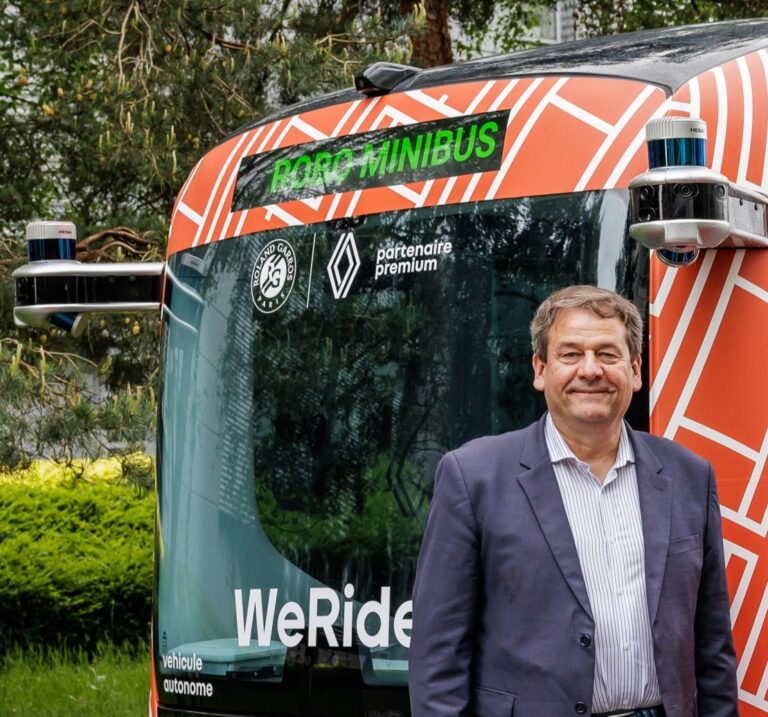AAVI recently caught up with Patrick Vergelas, head of autonomous driving projects at Renault Group, to find out more about his company’s ambitions for the autonomous shuttle/shared mobility market space.
The OEM manufactured the vehicles that provided an L4 driverless minibus shuttle service at the French Open tennis tournament held at Paris’s Stade Roland-Garros on May 26-June 9. The shuttles featured WeRide’s full-stack, self-developed autonomous driving software and hardware system, and took about about 12 minutes to travel a 5km route between the stadium and car parking facilities.
The long-term goal of Renault Group and WeRide is to jointly develop localized L4 driverless minibus solutions for public transportation in Europe, with commercial demand for driverless minibuses in Europe expected to reach several thousand units per year.
Please explain Renault’s design approach to autonomous shuttles – how does it differ?
Renault Group is developing a robotized, pre-equipped electric minibus platform, capable of hosting the various automation solutions of specialized partners, including WeRide, Milla and EasyMile.
The initial presence of a driver’s station and an operator on board is likely to reassure the first users of the service, as well as providing a solution to quickly supply minibuses, and to enable them to be driven from the depot to the line on which they will operate in autonomous mode, if reaching the start of the line is difficult in autonomous mode.
However, our experiments with vehicles without steering wheels and/or driver’s cabs have shown that users quickly get used to the absence of a driver’s cab, and it quickly becomes a non-issue for them.
Developing a vehicle without a cockpit may make sense in terms of “reclaiming” space for onboard users, especially as the targeted level of autonomy requires no operator inside the vehicle.
The vehicle’s onboard capacity has not yet been defined, but different configurations can be imagined according to the needs of local authorities.
What was the exact ODD for the vehicles in operation during the French Open?
The experiment carried out with WeRide during the Roland Garros [French Open] tennis tournament had to take place within a precise framework defined jointly with the French Federation of Tennis (FTT) under an authorization of experimentation delivered by the authority (Direction Générale de l’Énergie et du Climat) with the cities Boulogne-Billancourt and Paris.
The two autonomous shuttles used for the experiment traveled a total distance of almost 5km, on open roads, in the middle of traffic, at a maximum speed of 40km/h. Passengers on board had to be seated and wearing seat belts. Children and luggage were not allowed. There is no driver, but a remote supervisor is on board, which is part of the targeted business model, as well as a safety operator – just in case for this first experimentation.
The experiment ran with passengers from May 26 to June 9 , between 11.00am and 7:00pm.
As an OEM, where do you see the current challenges in manufacturing such vehicles?
The biggest challenge – and probably mistake – would be to try to do everything on your own, ignoring the expertise of specialized players, such as WeRide or EasyMile for example, who can better lead on autonomous technology and service operations, drawing on a supervision center with millions of kilometres of testing and operations.
At Renault Group, we are experts in vehicle development and manufacturing, electric vehicles, and adaptation to B2C, B2B and B2G customers’ needs, including small series and transformations.
The alliance of our respective areas of expertise makes sense in proposing a highly relevant range of autonomous, low-carbon minibus and shuttles to meet the growing needs of local public transport authorities.
Before 2030, the group is aiming to scale up commercial deployment of L4 autonomous vehicles for road public transports. To this end, Renault Group is developing a robotized, pre-equipped electric minibus platform, capable of hosting the various automation solutions of specialized partners (WeRide, Milla, EasyMile). Durability and cybersecurity are under study to provide a relevant solution.
What are the key criteria for operators and purchasers of these vehicles?
Public transport authorities and mass transit operators need reliable, flexible, electric, driverless solutions that are available when they need them. The autonomous minibus and shuttle meets this need and has the potential to operate 24/7, while answering the lack of drivers and helping to electrify bus fleets.
This solution allows a densification of the territorial network at controlled costs, compared to other existing, guided modes (train, tramway, bus). It can bring better efficiency in terms of total costs (investment and operation) and CO2 per passenger/km.
It is also a means of transport in line with the demanding context of ecological and digital transition – providing innovative electric vehicles with low noise levels and a reduced carbon footprint.
For clients, it can be a mobility offer available 24/7, easily accessible for those who want to reduce the use of their private car and for all those who don’t own one or no longer drive (senior citizens, young people without a license, etc).
What do you think is the market value/size for such vehicles?
The market is promising. It is estimated at several thousand vehicles a year by 2035. We do intend to be a major player in this sector, starting with Europe. In terms of value, the vehicle platform and the definition of the right vehicle is estimated at 70% of the price of the vehicle sold; and the technology at 30%.



